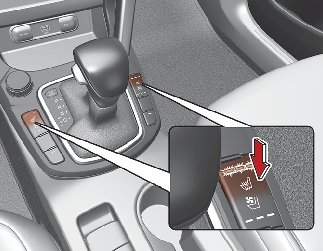Seat warmer (if equipped)

With the ignition switch in the ON position:
-
Push either of the switches to warm the driver's seat or the front passenger's seat.
During mild weather or under conditions where the operation of the seat warmer is not needed, keep the switches in the "OFF" position.
Each time you press the switch, the temperature setting of the seat will change as follows:

The seat warmer starts to automatically control the seat temperature in order to prevent low-temperature burns after being manually turned ON.

You may manually press the button to increase the seat temperature. However, it soon returns to the automatic mode again.
-
When pressing the switch for more than 1.5 seconds with the seat warmer operating, the seat warmer will turn OFF.
-
The seat warmer defaults to the OFF position whenever the ignition switch or ENGINE START/STOP button is in the ON position.

With the seat warmer switch in the ON position, the heating system in the seat turns off or on automatically depending on the seat temperature.

-
When cleaning the seats, do not use an organic solvent such as paint thinner, benzene, alcohol and gasoline. Doing so may damage the surface of the heater or seats.
-
To prevent overheating the seat warmer, do not place anything on the seats that insulates against heat, such as blankets, cushions or seat covers while the seat warmer is in operation.
-
Do not place heavy or sharp objects on seats equipped with seat warmers. Damage to the seat warming components could occur.
-
Do not change the seat cover. It may damage the seat warmer or air ventilation system.

Seat warmer burns
The seat warmer may cause burns, even at low temperature, if used over a long period of time. Never allow passengers who may not be able to take care of themselves to be exposed to the risk of seat heater burns. These include:
-
Infants, children, elderly or disabled persons, or hospital outpatients
-
Persons with sensitive skin or those that burn easily
-
Fatigued individuals
-
Intoxicated individuals
-
Individuals taking medication that can cause drowsiness or sleepiness (sleeping pills, cold tablets, etc.)